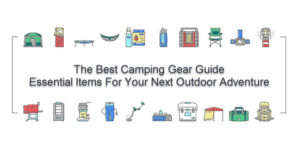Choosing a sleeping bag is an essential part of planning your camping trip. It can make or break your experience, so it’s crucial that you choose one that meets all your needs and preferences. Here are some tips on how to select the best sleeping bag for your next adventure:
Introduction to Sleeping Bags
Sleeping bags come in various shapes, sizes, materials, and insulation levels. They provide warmth and comfort while keeping you dry during cold nights. Some models have additional features such as storage pockets, pillows, and waterproof liners. The choice between synthetic or down fill depends on personal preference and climate conditions. Synthetics tend to be more durable but heavier than down, which provides better insulation but requires regular maintenance.
Types of Camping Sleeping Bags
There are three main types of sleeping bags available on the market: rectangular, mummy-shaped, and semi-rectangular. Rectangular bags offer maximum space and headroom but sacrifice heat retention due to their shape. Mummy-shaped bags hug the body tightly, providing excellent insulation and compactness at the expense of reduced movement range. Semi-rectangular bags combine both worlds by offering extra room around the shoulders and chest area with less restriction around the legs.
Double Sleeping Bag Benefits and Considerations
A double sleeping bag allows two people to share body heat without sacrificing much insulation compared to individual bags. However, they require more space and weight than single bags, making them ideal only for car camping trips where gear volume doesn’t matter. Double bags also don’t work well if one person wants to snore or move around while the other stays still.
Ultralight Sleeping Bags: The Best Option for Backpackers
If you plan to hike long distances, ultralight sleeping bags may be the way to go. These lightweight bags weigh just a few pounds yet provide ample warmth thanks to advanced insulating technologies like Primaloft and Thermolite. Ultralights typically use high-quality fabrics like silnylon or cuben fiber to minimize bulkiness and maximize compressibility. Look for bags rated below zero degrees Fahrenheit (-18°C) for colder climates.
Finding the Right Temperature Rating for Your Needs
Temperature ratings indicate the lowest temperature at which a sleeping bag will keep its user comfortable. A higher rating means greater insulation capacity, but it comes at the cost of added weight and bulkiness. Most manufacturers rate their products using a system based on the American National Standards Institute (ANSI). For example, a bag rated “20°F” indicates it should maintain a minimum temperature of 20°F inside the bag when exposed to external temperatures of -4°F. To find the right temperature rating for your needs, consider factors such as seasonality, location, weather patterns, and personal tolerance level.

Conclusion
In conclusion, choosing the right sleeping bag involves considering several factors including type, temperature rating, size, material, and insulation technology. By following these guidelines, you can ensure a comfortable and enjoyable camping experience regardless of the weather conditions.

